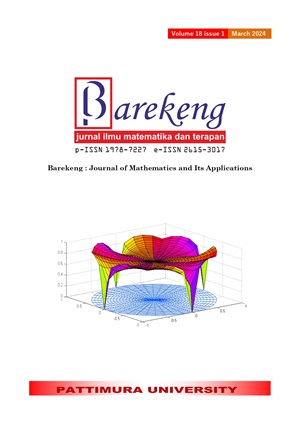SPREADING PATTERN OF INFECTIOUS DISEASES: SUSCEPTIBLE INFECTED RECOVERED MODEL WITH VACCINATION AND DRUG-RESISTANT CASES (APPLICATION ON TB DATA IN INDONESIA)
Abstract
Mycobacterium tuberculosis is the causative agent of the infectious illness tuberculosis (TB). Indonesia is the world's third-highest TB burden country. TB transmission is prevented by the BCG vaccination. A directly observed treatment, short-course (DOTS) treatment approach can cure TB illness. Recurrent TB may occur due to either relapse or reinfection with drug-resistant bacteria. The goals of this article are formulating the SVITR model with relapse and drug-resistant cases, applying the model to the TB data in Indonesia, determining the model accuracy, determining the spreading pattern and interpreting the result, and simulating the parameters. Literature study and application methods are used in this research. The SVITR model with relapse and drug-resistant cases is a first-order nonlinear differential equation system. The model is applied to TB in Indonesia based on annual data from Indonesian Health Profile, World Bank, and WHO. The model is solved by the fourth-order Runge-Kutta method. The model is accurate enough to explain the spread of TB in Indonesia with a MAPE value of 15,5%. The spreading pattern of tuberculosis infection is upward from 2010 to 2050. In 2050, there are still 8.115.976 TB cases in Indonesia. Hence in 2050, Indonesia's free of TB target has yet to be achieved. Simulation is conducted by increasing BCG vaccination to 95%, reducing contact with TB patients to 5%, increasing treatment to 95%, and lowering relapses and drug-resistant cases to 0.00005%, so the Indonesia free of TB target in 2050 can be achieved from 2042.
Downloads
References
J. Giesecke, Modern Infectious Disease Epidemiology, 3rd Ed., Boca Raton: CRC Press, 2017.
B. R. Bloom and P.-H. Lambert, The Vaccine Book, 2nd Ed., London: Academic Press, 2016.
A. Chokshi, Z. Sifri, D. Cennimo and H. Horng, "Global Contributors to Antibiotic Resistance," Journal of Global Infectious Diseases, vol. 11, no. 1, pp. 36-42, 2019.
WHO, "Global Report Tuberculosis," World Health Organization, [Online]. Available: https://www.who.int/teams/global-tuberculosis-programme/tb-reports/global-report-2022. [Accessed 2023].
CDC, The Role of BCG Vaccine in the Prevention and Control of Tuberculosis in United State: A Joint Statement by the Advisoru Council for the Elimination of Tuberculosis and the Advisory Committee on Immunization Practices, Washington DC: Epidemiology Program Office, 1996.
E. A. P. Coyotl, J. B. Palacios, G. Muciño, D. Moreno-Blas, M. Costas, T. M. Montes, C. Diener, S. Uribe-Carvajal, L. Massieu, S. Castro-Obregón, O. R. Espinosa, D. M. Espinosa, J. C. L. Contreras, G. Corzo, R. Hernández-Pando and G. D. Rio, "Antimicrobial Peptide Against Mycobacterium Tuberculosis That Activates Autophagy Is an Effective Treatment for Tuberculosis," Pharmaceutics, vol. 12, no. 1071, pp. 1-24, 2020.
W. Kermack and A. McKendric, "A Contribution to the Mathematical Theory od Epidemics," in Proceeding of Royal Society of London, London, 1927.
H. Hethcote, "Three Basic Epidemiological Models," Applied Mathematical Ecology, vol. 18, pp. 119-144, 1989.
I. Utari, "Kontrol Optimasi Upaya Pengobatan Penyakit Campak Menggunakan Model Epidemi SIR," Jurnal Matematika, vol. 9, no. 2, pp. 94-100, 2019.
S. Al-Temimi and H. Al-Shammrty, "Estimate the Endemic (SIR) Model of Monkey Pox Disease," Mathematical Stastician and Engineering Applications, vol. 71, no. 4, pp. 4921-4935, 2022.
X. Liu, S. Iwami and Y. Takeuchi, "SVIR Epidemic Models with Vaccination Strategies," Journal of Theoretical Biology, vol. 253, pp. 1-11, 2008.
S. Islam, "Equilibriums and Stability of SVIR Epidemic Model," International Journal of Humanities, Arts, Medicine and Sciences, vol. 3, pp. 1-10, 2015.
J. Harianto and T. Suprawati, "SVIR Epidemic Model with Non Constant Population," CAUCHY: Jurnal Matematika Murni dan Aplikasi, vol. 5, no. 3, pp. 102-111, 2018.
P. Widyaningsih, A. Nugroho, D. Saputro and Sutanto, "Tuberculosis Transmission with Relapse in Indonesia: Susceptible Vaccinated Infected Recovered Model," in Journal of Physics: Conference Series, No. 1217-012071, 2019.
N. Sacrifice, E. Okyere, N. Frempong, S. Akindeinde, J. Ankamah, J. Agyen and D. Adedia, "An SITR Analysis of Treatment Model of Hepatitis B Epidemic," Mathematical Theory and Modelling, vol. 5, no. 13, pp. 120-132, 2015.
S. Side, W. Sanusi and N. Setiawan, "Analisis dan Simulasi Model SITR pada Penyebaran Penyakit Tuberkulosis di Kota Makasar," Jurnal Sainsmat, vol. 5, no. 2, pp. 191-204, 2016.
A. Bezabih, G. Edessa and K. Rao, "Epidemiological Modelling and Analysis of COVID-19 Pandemic with Treatment," Mathem Modell Appl, vol. 6, no. 1, pp. 1-9, 2021.
A. Lestari, P. Widyaningsih and Sutanto, "Model Susceptible-Vaccinated-Infected-Treatment-Recovered (SVITR) dengan Kasus Kambuh dan Penerapannya (Kasus Tuberkulosis di Indonesia)," BAREKENG: Jurnal Ilmu Matematika dan Terapan, vol. 15, no. 4, pp. 667-674, 2021.
Data and Information Center, Indonesian Health Profile, Jakarta: Health of Ministry of Indonesia, 2010-2021.
World Bank, "Birth and Death Rate, Crude," World Bank, [Online]. Available: https://data.worldbank.org/indicator/SP.DYN.CRBT.IN. [Accessed 2023].
Copyright (c) 2024 Purnami Widyaningsih, Siti Roqhilu Yumaroh, Dewi Retno Sari Saputro

This work is licensed under a Creative Commons Attribution-ShareAlike 4.0 International License.
Authors who publish with this Journal agree to the following terms:
- Author retain copyright and grant the journal right of first publication with the work simultaneously licensed under a creative commons attribution license that allow others to share the work within an acknowledgement of the work’s authorship and initial publication of this journal.
- Authors are able to enter into separate, additional contractual arrangement for the non-exclusive distribution of the journal’s published version of the work (e.g. acknowledgement of its initial publication in this journal).
- Authors are permitted and encouraged to post their work online (e.g. in institutional repositories or on their websites) prior to and during the submission process, as it can lead to productive exchanges, as well as earlier and greater citation of published works.






1.gif)



